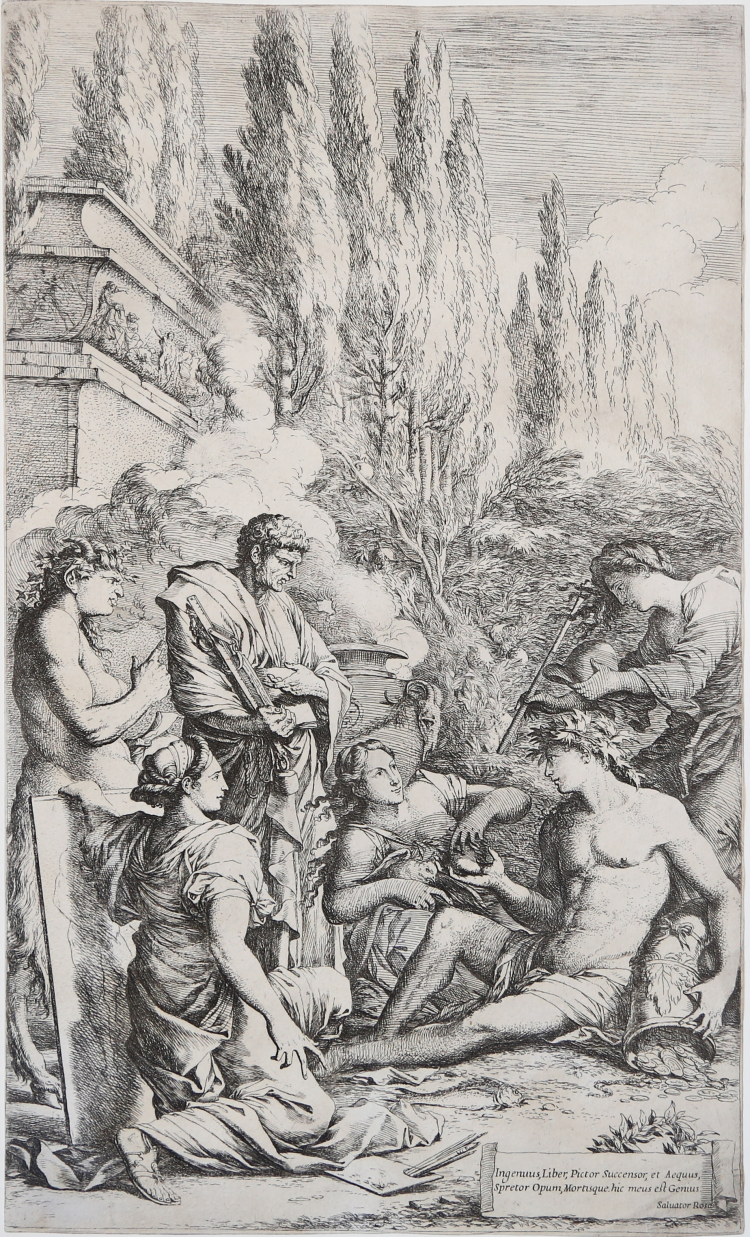




| Reference: | S44288 |
| Author | Salvator ROSA |
| Year: | 1662 ca. |
| Measures: | 270 x 460 mm |



| Reference: | S44288 |
| Author | Salvator ROSA |
| Year: | 1662 ca. |
| Measures: | 270 x 460 mm |
The genius of Salvator Rosa; right, the artist seated on the ground, one arm resting on an inverted cornucopia, surrounded by allegorical figures including Liberty, Painting, and Vice.
Etching with drypoint, ca. 1662, signed lower right Salvator Rosa. Example in the final third state, with hatching on the clouds of smoke.
Magnificent proof, rich in tone, printed on contemporary laid paper with unreadable watermark, trimmed to copperplate, in excellent condition.
Liberally based on the composition of Giovanni Benedetto Castiglione's Genius, of simpler layout, dominated by the central figure alone, Salvator Rosa has realized in this etching his manifesto of an artist's genius, codifying in the inscription the moral qualities linked to the ideal of Stoic philosophy of a free and just man, heedless of wealth and death.
Wallace has extensively studied the iconography of this print and its sources, the most important of which are Ripa's Iconologia, and Pierius Valerian's Hierogliphyca.
The Genius, naked and seated like Castiglione's crowned with ivy, is depicted offering his heart to Sincerity, a woman with a dove in her hand; behind him Liberty is about to put a Phrygian cap on him. The Genius appears stoically indifferent both to riches with his left arm holding an inverted cornucopia, and to death, symbolized by the tomb, the cypress trees, and the smoke rising from the stamnos.
On the left, kneeling, is Painting, which holds a painting and has a palette at its feet; in the center, the toggled figure with a book and scales in his hand is a depiction of Stoicism, to whose creed Rosa tried to adhere throughout his life, and finally, the satyr on the left is Satirical Poetry depicted with its Dionysian components.
The work, made in 1662, is influenced by a strong classical inspiration, particularly evident in the figure of the Genius, posed as a river god of antiquity, and Painting, copying a bystander in Raphael's Transfiguration.
Several preparatory drawings for this engraving are known; the final model, with the image in counterpart, is preserved in the Istituto Nazionale per la Grafica, Rome (inv. FC. 124795)
Bibliografia
Bartsch, Le Peintre graveur (XX.277.24); Wallace, The Etchings of Salvator Rosa (113.III); S. Massari, Tra Mito e Allegoria, pp. 456-57, n. 175; Gori Gandellini, 1815, XIII, p. 319, n. XV; Le Blanc, 1858, III, p, 360, n. 25; Rotili, 1974, pp. 222-23, n. e fig. 103; Mahoney, 1977, I, pp. 567-71, n. 65.14-18, n. 38.5; Costamagna, 1981, n. 151.
Salvator ROSA (Napoli 1615 - Roma 1673)
|
Like Testa, Castiglione and Della Bella, Salvator Rosa considered the art of engraving the best technique to express his talent and, it is not by chance that he is considered, together with the already mentioned artists, one of the protagonists of Italian seventeenth-century art.
Rosa was an extremely eclectic person; his main models in art were the classicism of Carracci, the naturalism of Ribera, the contemporary Roman painting and the ancient world.
From the latter in particular, Rosa drew inspiration for his engravings, whose subjects come from the old Stoic philosophy, with the glorification of virtues though allegories. We have also to consider his passion for esotericism, which inspired him with pictorial compositions with necromancy.
His technique and total command of etching enabled his prints to be appreciated even from his contemporaries, copied by them and highly requested by collectors.
|
Salvator ROSA (Napoli 1615 - Roma 1673)
|
Like Testa, Castiglione and Della Bella, Salvator Rosa considered the art of engraving the best technique to express his talent and, it is not by chance that he is considered, together with the already mentioned artists, one of the protagonists of Italian seventeenth-century art.
Rosa was an extremely eclectic person; his main models in art were the classicism of Carracci, the naturalism of Ribera, the contemporary Roman painting and the ancient world.
From the latter in particular, Rosa drew inspiration for his engravings, whose subjects come from the old Stoic philosophy, with the glorification of virtues though allegories. We have also to consider his passion for esotericism, which inspired him with pictorial compositions with necromancy.
His technique and total command of etching enabled his prints to be appreciated even from his contemporaries, copied by them and highly requested by collectors.
|